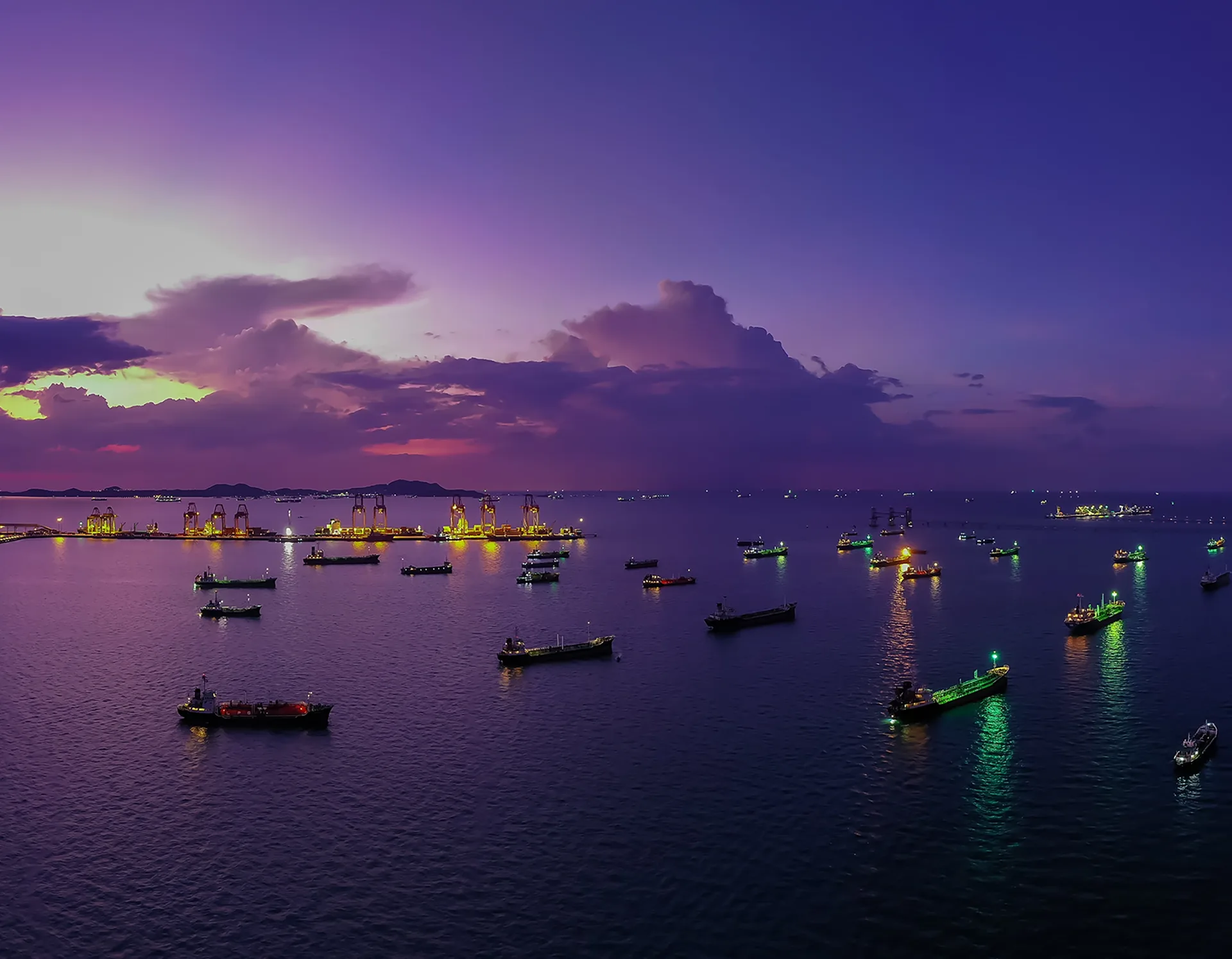Maritime supply chains remain the backbone of the global economy. Eighty percent of global trade by volume, and over seventy percent by value, is transported by sea. Maritime supply chain security is therefore paramount to prosperity worldwide, which means that monitoring threats is critical. This state of global maritime supply chains primer aims to identify and assess current and potential key threats to seaborne trade.
Current Disruptions
- Piracy: Piracy has been a key source of maritime supply-chain insecurity. Studies show overall exports along shipping routes impacted by maritime piracy decline in response to a rise in pirate activity—despite the relatively modest economic consequences of the attacks themselves. It has historically had a major impact on the well-being of crew members, as the potential for attacks alone can create stress and extend watch hour duties in mariners’ daily tasks—making the journey more arduous. Piracy has been particularly common near the West African coast, the Malacca Strait, and the South China Sea.
- However, recent data shows that the piracy threat has decreased over the last several years. According to the International Criminal Court’s International Maritime Bureau (IMB), incidents of piracy and armed robbery fell to the lowest levels in thirty years in the first nine months of 2024. The IMB reported 79 incidents from January to September 2024, a decrease from 99 incidents during the same period last year. Between January and September, 62 vessels were boarded, 6 were hijacked, 9 faced attempted attacks, and 2 were fired upon. In 86 percent of the incidents, the perpetrators successfully boarded the vessels, with most occurrences happening at night. Notwithstanding the overall decrease in attacks, concerns about violence against crew members persist: over the same period, 111 crew members were taken hostage, 11 were kidnapped, and 3 were threatened. In 45 of the reported incidents, the perpetrators were armed with weapons, including guns and knives. Nevertheless, thanks to multilateral naval operations, improved ship security practices, and enhanced navigation systems, the piracy issue has generally improved—ceding ground to other kinds of threats linked to geopolitical conflicts.
- Russian Invasion of Ukraine and the Black Sea: The Black Sea’s transformation into an active conflict zone has had important implications for global food security, as a consequential share of the world’s grains are transported through the region. Before Russia’s full-scale invasion, Ukraine accounted for about 10 percent of global wheat exports, 15 percent of global corn and barley exports, and 50 percent of global sunflower oil exports. In March, April, and May of 2022, after the Russian invasion, Ukraine’s agricultural exports dropped by over 90 percent. The United Nations’ Black Sea Grain Initiative (BSGI), which was in effect for nearly a year beginning in July 2022, made significant strides in improving the situation. Amid the ongoing conflict, it enabled Ukraine to export 33 million metric tons of grains and other agricultural products from its Black Sea ports, with the majority going to developing countries that are vulnerable to hunger crises.
- After the initiative expired in July 2023, Ukraine established its unilateral “humanitarian corridor.” By June 25, 2024, over 1,950 vessels had transported more than 55 million metric tons of cargo through Ukraine’s humanitarian corridor since its launch on August 15, 2023, including about 37.4 million metric tons of agricultural exports. The transition was not seamless—Russia intensified attacks on Ukraine’s export infrastructure, damaging 105 port facilities and destroying 280,000 metric tons of stored grain in under two months following the end of the BSGI. Currently, approximately 90 percent of Ukraine’s agricultural exports are shipped by sea, with prewar export levels being restored by April 2024. However, the conflict is not over—the sides have reached a quasi-stalemate (with Russia making some advances) and there is no definitive end in sight. Regional maritime supply chains remain at risk: Russia and Ukraine have previously shown the ability to target commercial vessels heading to each other’s ports in the Black Sea and the Sea of Azov. Port infrastructure continues to be a target, as evidenced by the ongoing Russian missile and unmanned aerial vehicle attacks on Odesa.
- Houthi Attacks and the Red Sea: Six weeks after Hamas carried out the October 7, 2023, attack against Israel, and Israel responded with a military campaign in the Gaza Strip, Houthi rebels in Yemen took control of a British-owned cargo ship in the Red Sea. The hijacking began a now year-long wave of attacks against commercial shipping in the Gulf of Aden and the Red Sea, a necessary route for vessels transiting the Suez Canal. According to the nonprofit Armed Conflict Location and Event Data, the Houthis have conducted 130 attacks in the Red Sea since the beginning of the war.
- The situation forces traders to choose between the conflict-affected route, which comes with danger as well as high insurance rates—with some insurers even refusing to insure Red Sea routes at all—or the longer route around the Cape of Good Hope, which incurs substantial costs and delays. The significantly increased risk of attacks has led shipping companies to reconsider using the Suez Canal via the Red Sea. Cargo insurance plays a crucial role in the decision to transit through these waters. Analysts have reported a sharp rise in rates for voyages through the Red Sea and Bab al-Mandab Strait. In addition, cargo insurers apply an extra war risk premium, further driving up the costs of using the Suez Canal route. Container vessels—which transport goods in shipping containers—and, to a lesser extent car carriers, have been rerouted most frequently. Container vessels often carry higher-value cargo, resulting in greater insurance costs compared to bulk carriers or hydrocarbon tankers.
- As of mid-September, the average daily transits through the Suez Canal was 29, down from approximately 80 last October. During the same period, the average daily trade volume fell from approximately 4.89 million metric tons to 1.36 million metric tons. The rerouting comes with significant downsides. For voyages between Europe and Asia, diverting to the Cape of Good Hope extends shipping time by 30 to 50 percent—elevating shipping costs given ensuing delivery delays and higher fuel demand. The rerouting can cost an additional $1 million per trip. Subsequent knock-on effects raise the prices of traded goods globally. J.P. Morgan Global Research estimated that disruptions in the Red Sea contributed an additional 0.7 percentage points to global core goods inflation in the first half of 2024.
Territorial claims are behind rising tensions in the region. Beijing asserts almost complete control over the South China Sea, provoking anger from its neighbors who argue that China’s territorial ambitions encroach on their exclusive economic zones. Recently, the Chinese military has engaged in increasingly aggressive actions in the area, including confrontations with Filipino vessels, raising concerns about the potential for a full-scale conflict. The United States has consistently warned that it is obligated to defend the Philippines in the event of an attack on its military, including within the South China Sea. Meanwhile, Vietnam’s foreign ministry has also recently denounced China’s actions in the South China Sea, accusing Chinese vessels of conducting a “violent attack” on Vietnamese fishing boats.
In support of its claims, China has reportedly employed “gray zone” tactics—coercive measures that stop short of armed conflict yet exceed typical diplomatic actions. As it stands, all parties involved, including China, do not seem to be willing to disrupt commercial activity in the region by addressing territorial disputes via large-scale military action. One area, however, may be the exception—the northernmost point of the South China Sea, namely the Taiwan Strait.
Previous CSIS work has estimated that around $2.45 trillion worth of goods, or over 20 percent of global maritime trade, transited the Taiwan Strait in 2022. Over 90 percent of advanced semiconductors are produced in Taiwan—with many production inputs such as processed minerals arriving via ships—and disruptions to the country’s chip ecosystem alone could cost the world trillions of dollars. Aside from the island’s own significant contributions to the global economy, conflict involving Taiwan would likely compel shipping companies to avoid routes around the island altogether. To that end, vessels heading to Korea and Japan would need to add 800–1,000 miles to the journey (depending on the destination) by sailing south and east of the Philippines. Much like the Red Sea reroutes, these changes would incur significant costs and delays, which would likely lead to knock-on effects on goods prices around the world. China itself is heavily dependent on the Taiwan Strait (21.6 percent of its total trade passes through it) and would experience negative economic impacts from any disruption to the flow of commerce through the strait.
Environmental Threats One of the most consequential effects of climate change is the rise in both the intensity and frequency of extreme weather events. The Fifth National Climate Assessment reports that the frequency of heat waves, heavy downpours, and major hurricanes has risen worldwide, along with an increase in the intensity of these events. Aside from the economic toll directly resulting from these catastrophes, increasingly frequent extreme weather events are set to endanger maritime supply chains.
- Extreme Weather Events and Port Infrastructure:Because maritime trade is the backbone of global trade, port infrastructure is crucial to the efficient movement of goods, with ports managing approximately 80 percent of global trade volume. Many ports are vulnerable to operational disruptions due to extreme weather events, leading to expensive downtime. The most severe events can inflict significant physical damage and leave ports inoperable for extended periods. For example, operations at the ports of Shanghai and Ningbo are disrupted for an average of 5–6 days each year due to extreme wind conditions. Hurricane Helene has caused significant damage to ports, particularly along Florida’s Gulf Coast. Ports like Port Tampa Bay and SeaPort Manatee were temporarily closed due to unprecedented storm surges and strong winds.
- Droughts and Waterways:Toward the end of 2023 and the first half of 2024, water levels in Gatun Lake—a vital water source for the Panama Canal—fell to record lows. The Panama Canal Authority was forced to cut the maximum number of ships allowed to pass through the canal daily. The restrictions have resulted in delays, higher shipping costs, and uncertainty regarding the future of one of the world’s key trade chokepoints. About 5 percent of the world’s seaborne trade, and 40 percent of U.S. container traffic ($270 billion in cargo), passes through the canal annually.
Growing instances of drought will be a problem for shipping around the world. In 2023, droughts affected several major trade routes, including the Yangtze River in China and the Mississippi River in the United States, while water levels in the Amazon River at the Port of Manaus in Brazil hit their lowest point since 1902. The summer of 2022 saw drought and low water levels in the Rhine River, which usually carries over 300 million tons of goods annually between the North Sea port of Rotterdam and central Europe.
Conclusion Maritime supply chains will continue to underpin the global economy—but they face a variety of threats both present and future stemming from geopolitical tensions and environmental factors. With crucial ports and waterways often located near zones of conflict, even non-state actors have the power to significantly harm global trade flows and drive up prices. In addition, geopolitical tensions have become an increasingly likely source of disruption, with potentially devastating implications. Threats from storms, drought, and flooding, while already a reality, should be expected to worsen with rising global temperatures.
Source: CSIS




